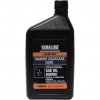Fishtales
Well-Known Member
- Joined
- Jan 31, 2005
- Messages
- 8,232
- Reaction score
- 1,344
- Points
- 113
I'm probably the minority here, but I fully service my motor yearly. Change out impeller, plugs, thermostats, oil, filter, gear lube, fuel filter and separator, grease fittings. I've done it this way for years, motor is always fresh and ready to go in the spring.
agree, I do the t-stats every 3 but the same on everything else. why chisel out?


